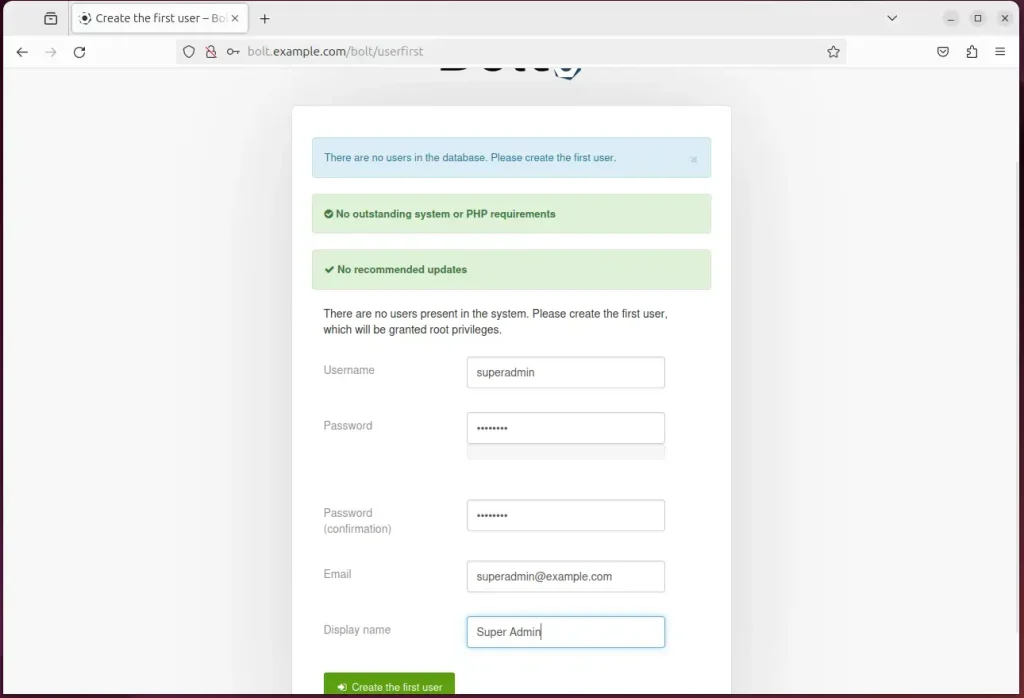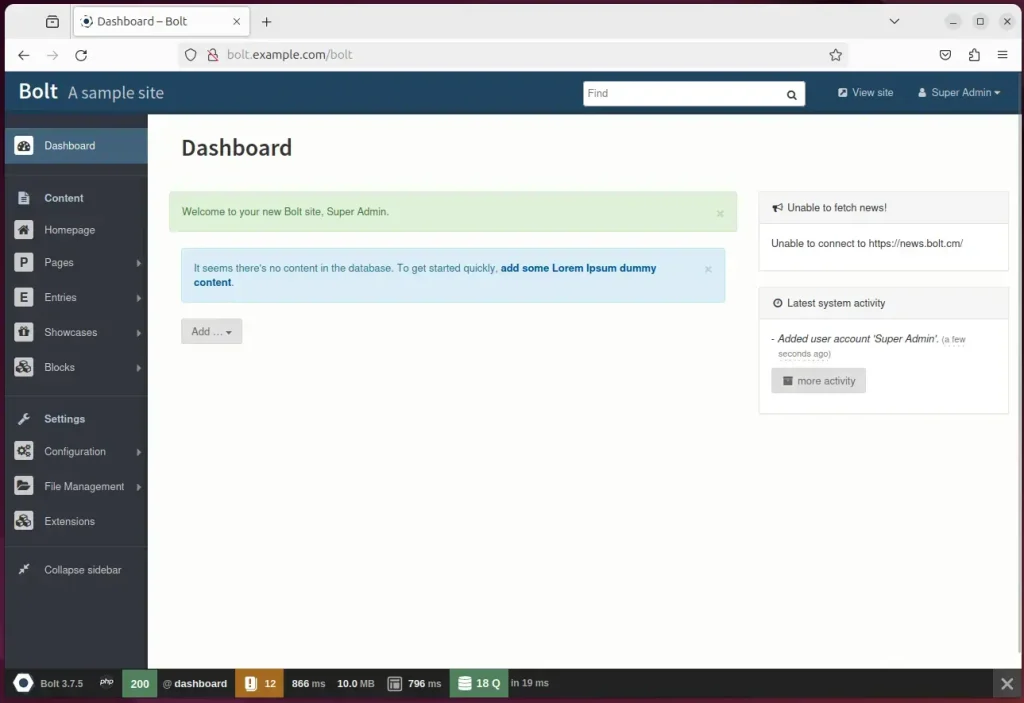This article explains installing Bolt CMS with Apache support on Ubuntu 24.04.
Installing Bolt CMS with Apache on Ubuntu offers a powerful and flexible combination for building and managing websites. Apache, a widely used web server, is known for its stability and robust performance.
This reliability ensures that your website will always be up and running, providing a secure and efficient environment for Bolt CMS to operate.
With this setup, you can confidently create and manage dynamic, engaging websites, making it a popular choice for web developers and site owners.
The steps below walk you through installing Bolt CMS with Apache on Ubuntu 24.04.
Install Apache HTTP server on Ubuntu
Bolt requires a web server. This post will install and use the Apache web server to run Bolt.
To do that, open the Ubuntu terminal and run the commands below to install the Apache web server.
sudo apt update
sudo apt install apache2
Once Apache is installed, the commands below can start, stop, and enable the Apache web server to start automatically when your server boots up.
sudo systemctl stop apache2
sudo systemctl start apache2
sudo systemctl enable apache2
You can test that the Apache web server is running by opening your web browser and browsing to the server’s localhost or IP address.
http://localhost

When you see the Apache2 Default Page, it means the Apache HTTP server is successfully installed.
Additional help on installing Apache on Ubuntu is in the link below.
How to install Apache on Ubuntu
Install the MariaDB database server on Ubuntu
The next component required to run Bolt is a database server. This post will install and use the MariaDB database server.
To install and use the MariaDB database server, use the instructions below.
Open the Ubuntu terminal and run the commands below to install the MariaDB database server.
sudo apt update sudo apt install mariadb-server
Once the MariaDB database server is installed, use the commands below to stop, start, and enable the MariaDB server to start automatically when the server boots.
sudo systemctl stop mariadb sudo systemctl start mariadb sudo systemctl enable mariadb
Run the following commands to validate and test if the MariaDB database server is installed successfully.
sudo mariadb
Once you run the commands above, it will log you onto the MariaDB console and display a message similar to the one below.
Welcome to the MariaDB monitor. Commands end with ; or \g. Your MariaDB connection id is 32 Server version: 10.11.2-MariaDB-1 Ubuntu 23.04 Copyright (c) 2000, 2018, Oracle, MariaDB Corporation Ab and others. Type 'help;' or '\h' for help. Type '\c' to clear the current input statement. MariaDB [(none)]>
The message tells you that the server is installed successfully.
Additional help on installing MariaDB.
Create a Bolt database
Upon successfully installing the MariaDB database server, create a blank database on the server specifically for the Bolt application.
As part of the setup, we will create a boltdb database and a user account called boltdbuser.
Finally, we’ll grant the boltdbuser full access to the boltdb database.
All the database steps above can be done using the commands below:
But first, log on to the MariaDB database server:
sudo mariadb
Then run the commands below to complete the steps:
CREATE DATABASE boltdb CHARACTER SET utf8mb4 COLLATE utf8mb4_general_ci;
CREATE USER boltdbuser@localhost IDENTIFIED BY 'type_your_password_here';
GRANT ALL ON boltdb.* TO boltdbuser@localhost WITH GRANT OPTION;
FLUSH PRIVILEGES;
exit
Ensure to replace ‘type_your_password_here ‘with your password.
Install PHP on Ubuntu Linux
The last component you will need to run Bolt is PHP. The Bolt application is PHP-based and does not support the latest versions of PHP.
To install an older version of PHP, add this repository.
sudo add-apt-repository ppa:ondrej/php
Then, run the commands below to install the PHP 7.2 version.
sudo apt install php7.2 libapache2-mod-php7.2 php7.2-intl php7.2-mysql php7.2-curl php7.2-cli php7.2-zip php7.2-xml php7.2-gd php7.2-common php7.2-mbstring php7.2-xmlrpc php7.2-json php7.2-sqlite3 php7.2-soap php7.2-zip
Additional help on installing PHP
How to install PHP on Ubuntu Linux
Download Bolt files
Let’s begin downloading and configuring the Bolt files on Ubuntu Linux.
First, install Composer, Curl, and other dependencies.
sudo apt install curl git curl -sS https://getcomposer.org/installer | sudo php -- --install-dir=/usr/local/bin --filename=composer
Then, navigate to the /var/www/ directory and clone the Bolt files. Next, make a copy of Bolt’s sample config.yml.dist file to create a new one called config.yml.
cd /var/www
sudo git clone https://github.com/bolt/bolt.git
sudo cp /var/www/bolt/app/config/config.yml.dist /var/www/bolt/app/config/config.yml
Next, open the Bolt config.yml file using the command below.
sudo nano /var/www/bolt/app/config/config.yml
Then, add the database name, username, and password created above. Save the file and exit.
# If you're trying out Bolt, just keep it set to SQLite for now.
database:
driver: mysql
databasename: boltdb
username: boltdbuser
password: your_strong_password
After setting up your environment above, change to the bolt directory and install all required PHP dependencies for Bolt CMS using Composer.
cd /var/www/bolt
sudo composer install
sudo chown -R www-data:www-data /var/www/bolt
Once you have completed all the above steps, continue configuring the Apache web server below to serve the Bolt content.
Run the commands below to create an Apache virtual host file for Bolt.
sudo nano /etc/apache2/sites-available/bolt.conf
Then, copy and paste the content block below into the Apache server block.
<VirtualHost *:80>
ServerName bolt.example.com
ServerAlias www.bolt.example.com
ServerAdmin [email protected]
DocumentRoot /var/www/bolt
<Directory /var/www/bolt/>
Options FollowSymlinks
AllowOverride All
Require all granted
</Directory>
ErrorLog ${APACHE_LOG_DIR}/error.log
CustomLog ${APACHE_LOG_DIR}/access.log combined
</VirtualHost>
Save the file.
Then, run the commands below to enable the virtual host and restart the Apache server.
sudo a2ensite bolt.conf
sudo a2enmod rewrite
sudo systemctl restart apache2
Setup Let’s Encrypt SSL/TLS for Bolt
You may want to install an SSL/TLS certificate to secure your Bolt site. Secure your Bolt installation with HTTPS from Let’s Encrypt.
Please read the post below for additional resources on installing and creating Let’s Encrypt SSL certificates for Apache.
How to set up Let’s Encrypt SSL certificate for Apache on Ubuntu Linux
Once you have restarted the Apache web server, open your browser and browse to the server hostname or IP address defined in the Apache server block.
http://bolt.example.com/
A Bolt setup wizard page should appear. Create the first user for the site.

Your Bolt site should be set up and ready to use.

That should do it!
Conclusion
- Installing Bolt CMS with Apache on Ubuntu grants you the stability of the widely used Apache web server for exceptional performance and reliability.
- The addition of the MariaDB database server provides secure and robust support for dynamic website content, ensuring a solid foundation for your Bolt CMS installation.
- Setting up the Bolt database and creating a user account is easy, with clear step-by-step instructions, ensuring a seamless integration process.
- Installing the required PHP components, configuring Bolt files on Ubuntu, and installing the Let’s Encrypt SSL/TLS certificate establishes a well-rounded environment for a secure and efficient Bolt CMS deployment.

Leave a Reply